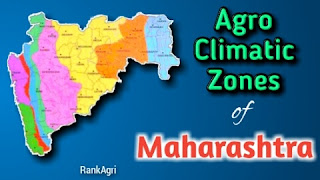How and why Maharashtra is divided in Agro climatic region??
As like 15 Agro Climatic zones of India, Maharashtra also have Agro Climatic zones.
Maharashtra Divided in 9 Agro Climatic regions on basis of Geographical location, Climate, Soil type, Vegetation, Topography and Cropping pattern as Follows :
List of Agro climatic zones of Maharashtra with Headquarters :
| Zone | Research station |
|---|---|
| South Konkan Coastal zone | Vengurla |
| North Konkan Coastal zone | Karjat |
| Western Ghat zone | Igatpuri |
| Sub Mountain zone | Kolhapur |
| Western Maharashtra Plain zone |
Pune |
| Western Maharashtra Scarcity zone |
Solapur |
| Central Maharashtra Plateau zone |
Aurangabad |
| Central Vidharbha zone | Yavatmal |
| Eastern Vidharbha zone | Sindhewahi |
Agro climatic zones of Maharashtra map :
 |
| Image Credit : ICAR-ATARI Pune |
Characteristics of Agro Climatic zones of Maharashtra
1. South Konkan Coastal zone / Very High Rainfall With Lateritic Soils (VRL) :
Area : This zone includes the whole of ratnagiri district, western border strip of Kolhapur district, manad and poladpur talkukas of kolaba district.
Climate : Warm and humid. Annual rainfall is more than 2500 mm. the maximum temperature range is 30° to 31°C while minimum temperature is in between 22° to 24°C.
Vegetation : vegetation is dense with moist, deciduous forest and savanna tree.
Topography : The general topography is hilly to undulating and the soil depth varies from less than 30 cm on hill slopes to about 100 to 150 cm in valleys.
Soil : soils are red to reddish brown derived from laterites which are developed by the process of laterization having sandy loam to clayey loam texture.
Cropping pattern : Paddy, nagli, wari and sawa are the main crops. In heavy soils, paddy is followed by wal.
2. North Konkan Coastal zone / Very High Rainfall with Non Lateritic Soils (VRN) :
Area : This zone consist of whole Thane district, remaining parts of Kolaba district and Western parts of Nasik district which include Igatpuri. Trimak, Peint and Surgana talukas.
Climate : The climate is warm and humid than First zone and mean annual range of maximum and minimum temperature is also more.
Vegetation : Natural vegetation is moist deciduous open/ forest with shrub type savanna.
Topography : is hilly to undulating.
Soil : Soils are non-lateritic and formed under intense leaching. Depth varies from 30 to 120 cm.
Cropping pattern : Crop grown are paddy, hagli, wari and sawa and on heavy soils wheat and gram are also taken.
3. Western Ghat Zone (GH) :
Area : The area include under this zone comprises the ghats of Amboli, Fonda and Amba in Kolhapur district, Koyang and Mahabaleshwar in Stara district, Lonawala and Khandala in Pune district, Kalsepar hills of Ahmednagar district and Igatpuri and Trimbak in Nasik district
Climate : Annual rainfall is more than 5,000 mm. The maximum and minimum temperature are the lowest among all the zones.
Vegetation : The natural vegetation is deciduous to semi-deciduous forests.
Soil & Cropping pattern : The soils are mostly wark as which grow hill millets like wari and sawa and oilseed crop like niger.
4. Sub mountain zone / Transition 1 with Red to Reddish Brown Soils (TRI) :
Area : The zone is a narrow strip running parallel to eastern side of Sahyadri ranges. It includes the part of Kolhapur, Sangli, Satara, Pune and Ahmednagar district.
Climate : The rainfall is in between 2500 to 1750 mm.
Vegetation : The natural vegetation is savanna type tree and shrub.
Soil : Soils are mainly red to brown with varying depths and texture.
Cropping pattern : Main crops grown are poddy, nagil, and niger.
5. Western maharashtra plain zone / Transition 2 with Greyish Black Soils (TR2) :
Area : This zone consist of a wide stripe running parallel and to the eastern size of Transition Zone 1 and extends towards east upto the line where scarcity zone starts. It comprises part of Kolhapur, Satara, Pune, Ahmednagar, Nasik and Dhulia District.
Climate : The annual rainfall ranges from 1750 to 700 mm.
Soil : soils formed from trap rock are greyish black in colour and varying texture.
Vegetation : The natural vegetation is of shrub.
Cropping pattern : The area mostly grow Paddy, Pearl millet, Sorghum, Groundnut and irrigated Cotton.
6. Western Maharashtra Scarcity zone / Scarcity Zone (SC) :
Area : It is a vast area in mid-western Maharashtra, it is a famine area of the state. It includes eastern parts of Sangli, Satara, Pune, Ahmednagar, Nasik and Dhulia district and western part of Jalgaon, Osmanabad and whole of Solapur district excluding Barsi, Solapur and Akkalkot taluka.
Climate : The annual rain fall ranges from 500 to 700 mm.
Vegetation : The natural vegetation is of low. scattered shrubs with discontinuous thorny thickets.
Soil : The soils are calcareous, greyish black in colour and of varying depth and textures.
Cropping pattern : The crops cultivated during kharif are Pearl millet, Urd and Mothbean on lighter type of soil. Rabi crops like wheat, gram, rabi jowar, safflower are taken on finer and deeper soils.
7. Central Maharashtra Plateau zone / Assured Rainfall with Mainly Kharif Cropping (ARK) :
Area : This zone includes the remaining parts of Sholapur. Osmanabad. Beed. Aurangabad and Jalgaon districts and western half of Parbhani district and southern Nanded district.
Climate : The rainfall on westem side is 700 mm and increases upto 900 mm on eastern side.
Soil : Soils are similar to those of zone 6 and in deep clayey soil problem of temporary water logging is observed.
Cropping pattern : Most of the kharif crops are grown.
8. Central vidharbha zone / Moderate to Moderately High Rainfall with Soils Formed from Trap (MR) :
Area : It includes the remaining parts of Nanded. Parbhani, Akola and Amrabats district, whole of Yeotmal and Wardha district, whole of Nagpur excluding Umerd, Nagpur and Ramtek talukas and western part of Chandrapur district.
Climate : The annual rainfall is 900 mm on western side and 1250 mm cantern side.
Soil : The soils are calcareous, greyish black in colour with varying depth and texture. Temporary waterlogging problem exists.
Cropping pattern : Kharif crop like cotton, jowar, ground ind soybean etc. are cultivated and in rabi crops like wheat, gram and linseed are grown.
9. Eastern vidharbha zone / High Rainfall with Soils Formed from Mixed Rocks (HRM) :
Area : It comprises whole of Bhandara district and the remaining parts of Nagpur and Chandrapur district.
Climate : It has higher rainfall which ranges from 1250 mm to 1700 mm.
Vegetation : The natural vegetation is of deciduous open' forests with thickets.
Soil : The soils are derived from granite, gneiss and schist and are yellowish brown red in colour and coarse in texture.
Cropping pattern : The major area is under paddy during kharif season and wheat, gram, linseed and rabi jowar are grown during rabi season .
Conclusion :
These are the 9 Agro-climatic zones of Maharashtra. They divided in agroclimatic zones on basis of geographical location, climate, soil, vegetation and crop pattern in Maharashtra.
Read also :
Fathers of Agriculture Disciplines
Frequently Asked Questions (FAQ's) :
1. What is agro climatic zone?Answer :- Agro climatic zone is land unit in terms of climate, soil type, geographical location suitable for crops.
2. How many agro climatic zones are there in Maharashtra?
Answer :- Total Nine (9) Agro climatic zones in maharashtra on basis of geographical location, climate, vegetation, soil type and cropping pattern.
3. How many agro climatic zones are there in India?
Answer :- Total Fifteen (15) Agro climatic zones in India on basis of geographical location, climate, vegetation, soil type, irrigation development, mineral resources and cropping pattern.







